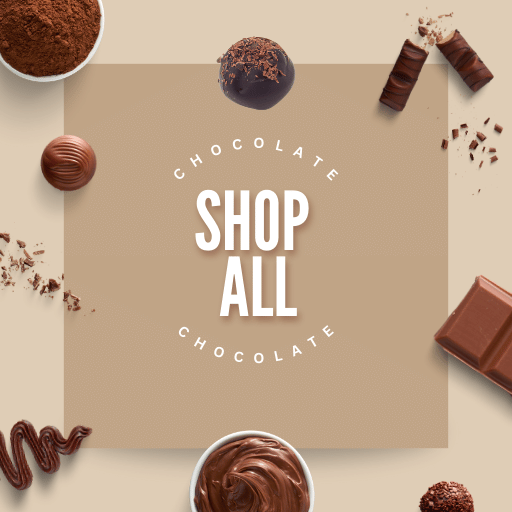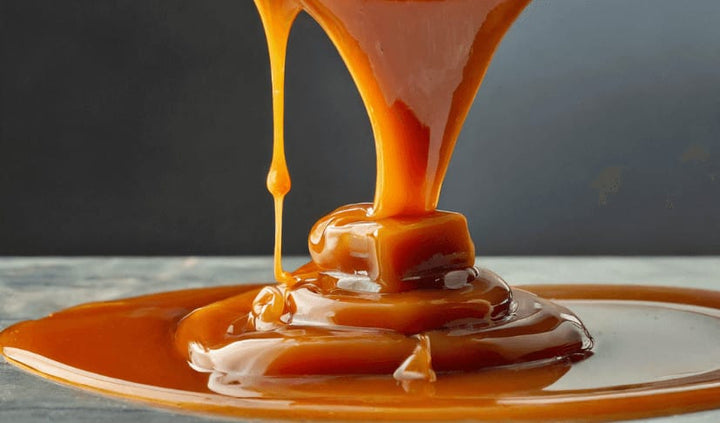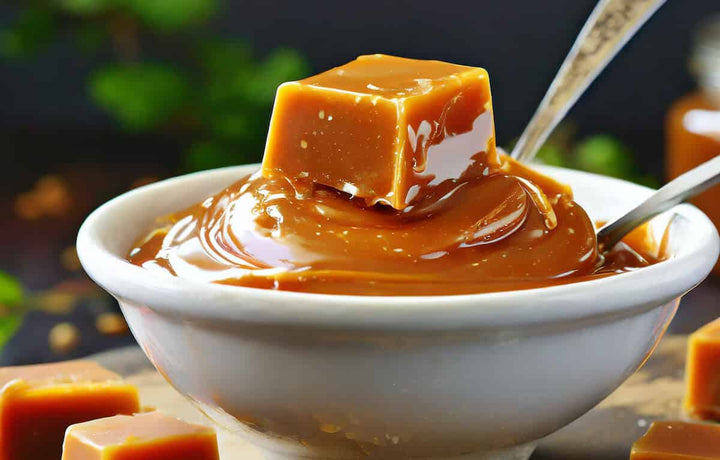Caramel is a rich, sweet confection adored by millions around the globe and has a history as delicious as its taste.
This post dives into the fascinating journey of caramel, from its early beginnings to becoming a staple in sweets and desserts.
We trace back to the possible inventors and the evolution of caramel making, exploring how this delectable treat has captivated taste buds across centuries.
Who Invented Caramel?
The precise origins of caramel are somewhat nebulous, as it is with many ancient confections, making it challenging to pinpoint a single inventor.
Caramel likely emerged due to experimentation with sugar, a commodity that has been refined and enjoyed in various forms for thousands of years.
Historical records suggest that cooks first made caramel in the early 17th century, possibly in France or the Arab world, where sugar cultivation and refinement were well established.
The word 'caramel' itself is derived from the Spanish 'caramelo', but its etymology traces further back to Medieval Latin 'cannamellis', which in turn comes from 'canna' (cane) and 'mellis' (honey), indicating the sweet's early association with sugar and perhaps honey before the widespread use of sugar.
In its simplest form, caramel is made by heating sugar until it breaks down and reforms into a complex, flavorful compound with a dark golden-brown colour.
This process, known as caramelization, is the foundation of caramel-making.
Over time, culinary artisans added ingredients such as cream, butter, and vanilla, transforming it into the creamy, chewy confection we adore today.
Various cultures and technological advancements in sugar refinement and confectionery techniques have influenced the evolution of caramel.
For instance, the introduction of condensed milk in the 19th century by American confectioners significantly changed the texture and taste of caramel, making it softer and more popular.
While it's difficult to credit a single individual with the invention of caramel, it's clear that its development was a gradual process influenced by various culinary traditions and innovations.
Today, caramel remains a testament to human ingenuity in confectionery, enjoyed in countless forms worldwide.
Related Post: Learn About Turkish Delight

When Was Caramel Invented?
Caramel is believed to have been invented in the early 17th century, around the 1600s.
However, its invention's exact date and place remain unclear due to the widespread use of sugar and caramelisation techniques across different cultures at the time.
What is Caramel?
Caramel is a sweet, rich confection made by heating a variety of sugars until they become deeply golden in colour and develop a complex flavour profile ranging from sweet and buttery to slightly bitter.
The process, known as caramelisation, involves the thermal decomposition of sugar, which occurs when sugar is heated to around 170°C (338°F).
Depending on the recipe, ingredients such as milk, cream, butter, and vanilla may be added to the caramelised sugar to create different types of caramel, including soft, chewy candies, a thick, pourable sauce, or a firm, brittle sheet.
Caramel is a standalone treat, a flavouring for desserts and beverages, or a filling for chocolates and other confections.

What is the Future of Caramel?
The future of caramel looks both promising and innovative, reflecting broader trends in the food and confectionery industry.
As consumers become increasingly interested in the provenance and composition of their food, the demand for caramel made with natural, high-quality ingredients and alternative sweeteners is likely to grow.
This includes organic sugars, non-dairy alternatives for cream and butter, and natural flavourings to cater to vegan, lactose-intolerant, and health-conscious consumers.
Additionally, the culinary world's continuous quest for innovation may lead to new and exciting applications of caramel.
This could include its incorporation into savoury dishes, fusion cuisine, and gourmet products as chefs and food manufacturers explore the versatility of caramel beyond traditional confectionery.
Sustainability will also play a crucial role in the future of caramel production.
With increasing awareness of environmental issues, there will be a push towards more sustainable sugar cultivation practices and eco-friendly packaging for caramel products.
Moreover, technological advancements in food processing and flavour extraction could lead to novel ways of producing caramel, enhancing its flavour profile and texture without compromising quality or nutritional value.
In essence, the future of caramel is set to be marked by a blend of tradition and innovation, with a strong emphasis on sustainability, health, and global culinary trends, ensuring its place in the hearts of sweet lovers for years to come.

What Does Caramel Taste Like?
Caramel is renowned for its rich, complex flavour profile encompassing many taste sensations.
At its core, caramel has a deep, sweet taste with a buttery richness that melts smoothly in the mouth.
As sugar caramelises, it develops a toasted, slightly burnt flavour that adds depth and a hint of bitterness, creating a balanced contrast to the sweetness.
Adding ingredients like cream, butter, and vanilla further enriches caramel's flavour, introducing notes of creaminess, silkiness, and a subtle floral sweetness.
Depending on how it's prepared, caramel can range from soft and chewy to hard and crunchy, with its taste varying slightly based on the degree of caramelisation and the specific recipe used.
The longer the sugar is heated, the more complex and intense the flavour becomes, sometimes acquiring a smoky or nutty undertone.
Where Can You Buy Tasty Chocolate?
Whitakers Chocolates, renowned for our long history in crafting delicious and affordable chocolates, offers a range of options suitable for everyone, including vegetarian, vegan, and gluten-free choices.
Our top-selling products, such as indulgent Coffee Creams, Neapolitans, Chocolate Wafer Thins, Stem Ginger and Luxury Chocolate Truffles, are perfect for enhancing your mocha coffee experience.
Click here to see our full range of delicious chocolates…
Some Notes From an Expert Chocolatier
One of the most exciting aspects of my craft is the exploration and integration of diverse confectionery ingredients into chocolate creations.
The marriage of chocolate with sweet confections such as caramel offers a canvas of complexity that elevates the chocolate experience to new heights.
Caramel, with its rich, buttery depth and the perfect hint of burnt sweetness, adds a layer of flavour that complements the robust, sometimes bitter notes of chocolate beautifully.
What fascinates me most is the delicate balance that needs to be struck when incorporating caramel into chocolate.
The process is not just about combining two flavours; it's about creating a harmonious blend where each ingredient enhances the other without overpowering it.
The viscosity and texture of the caramel are also crucial; it must be just right to meld seamlessly with the chocolate, ensuring a smooth, indulgent experience with every bite.
Over the years, I've experimented with various caramel preparations – from soft, flowing centres that offer a burst of sweetness to firmer, chewier inclusions that provide a satisfying texture contrast.
Each variation opens up a different dimension of taste and sensory pleasure, showcasing the versatility of caramel as an ingredient.
Final Notes On the Invention of Caramel
The invention of caramel stands as a testament to the enduring allure of confectionery innovation.
Its origins, shrouded in the mists of time, reflect a culinary journey that spans centuries and cultures.
Emerging from the simple act of heating sugar, caramel has evolved into a sophisticated and beloved ingredient that transcends borders and culinary traditions.
Its rich, complex flavour profile and versatile texture have made it a cornerstone in sweets and desserts.
The journey of caramel from a basic sugar concoction to a gourmet ingredient encapsulates the essence of culinary evolution.
It highlights not only the creativity and ingenuity of cooks and confectioners through the ages but also the global nature of food traditions that borrow, adapt, and refine.
As we look to the future, caramel inspires chefs and chocolatiers, promising new and exciting creations that will tantalise taste buds for future generations.











